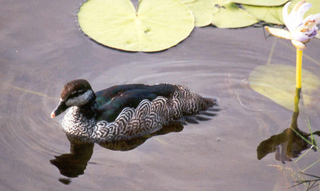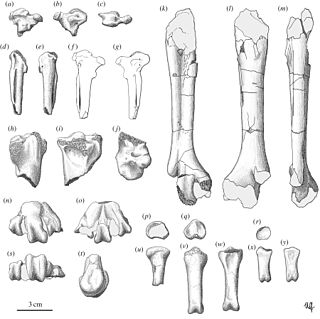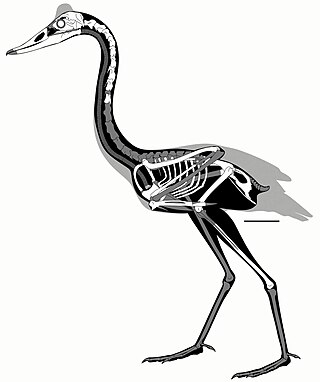
Anseriformes is an order of birds also known as waterfowl that comprises about 180 living species of birds in three families: Anhimidae, Anseranatidae, and Anatidae, the largest family, which includes over 170 species of waterfowl, among them the ducks, geese, and swans. Most modern species in the order are highly adapted for an aquatic existence at the water surface. With the exception of screamers, males have penises, a trait that has been lost in the Neoaves. Due to their aquatic nature, most species are web-footed.

The screamers are three South American bird species placed in family Anhimidae. They were thought to be related to the Galliformes because of similar bills, but are more closely related to the family Anatidae, i.e. ducks and allies,, and the magpie goose, within the clade Anseriformes. The clade is exceptional within the living birds in lacking uncinate processes of ribs. The three species are: The horned screamer ; the southern screamer or crested screamer ; and the northern screamer or black-necked screamer.

The Oxyurini are a tribe of the duck subfamily of birds, the Anatinae. It has been subject of considerable debate about its validity and circumscription. Some taxonomic authorities place the group in its own subfamily, the Oxyurinae. Most of its members have long, stiff tail feathers which are erected when the bird is at rest, and relatively large, swollen bills. Though their relationships are still enigmatic, they appear to be closer to swans and true geese than to the typical ducks. The highest diversity is found in the warmer parts of the Americas, but at least one species occurs in a major part of the world.

Mergus is the genus of the typical mergansers fish-eating ducks in the subfamily Anatinae. The genus name is a Latin word used by Pliny the Elder and other Roman authors to refer to an unspecified waterbird.

The magpie goose is the sole living representative species of the family Anseranatidae. This common waterbird is found in northern Australia and southern New Guinea. As the species is prone to wandering, especially when not breeding, it is sometimes recorded outside its core range. The species was once also widespread in southern Australia but disappeared from there largely due to the drainage of the wetlands where the birds once bred. Due to their importance to Aboriginal people as a seasonal food source, as subjects of recreational hunting, and as a tourist attraction, their expansive and stable presence in northern Australia has been "ensured [by] protective management".

Anseranatidae, the magpie-geese, is a biological family of waterbirds. The only living species, the magpie goose, is a resident breeder in northern Australia and in southern New Guinea.

Anas is a genus of dabbling ducks. It includes the pintails, most teals, and the mallard and its close relatives. It formerly included additional species but following the publication of a molecular phylogenetic study in 2009 the genus was split into four separate genera. The genus now contains 31 living species. The name Anas is the Latin for "duck".

Mergellus is a genus of duck. The smew (Mergellus albellus) is the only living species, but an extinct species known as Mergellus mochanovi has also been described from Late Pleistocene deposits in the Yakutia region of Russia.

Aythya is a genus of diving ducks. It has twelve described species. The name Aythya comes from the Ancient Greek word αυθυια, which may have referred to a sea-dwelling duck or an auklet.

The horned screamer is a member of a small family of birds, the Anhimidae, which occurs in wetlands of tropical South America. There are three screamer species, the other two being the southern screamer and the northern screamer in the genus Chauna. They are related to the ducks, geese and swans, which are in the family Anatidae, but have bills looking more like those of game birds.

The pygmy geese are a group of very small "perching ducks" in the genus Nettapus which breed in the Old World tropics. They are the smallest of all wildfowl. As the "perching ducks" are a paraphyletic group, they need to be placed elsewhere. The initially assumed relationship with the dabbling duck subfamily Anatinae has been questioned, and it appears they form a lineage in an ancient Gondwanan radiation of waterfowl, within which they are of unclear affinities. An undescribed fossil species from the late Hemphillian of Jalisco, central Mexico, has also been identified from the distal end of a tarsometatarsus. It is only record of the genus in the New World.

The southern screamer is a species of bird in family Anhimidae of the waterfowl order Anseriformes. It is found in Argentina, Bolivia, Brazil, Paraguay, Peru, and Uruguay.

The northern screamer is a Near Threatened species of bird in family Anhimidae of the waterfowl order Anseriformes. It is found in Colombia and Venezuela.

Presbyornis is an extinct genus of anseriform bird. It contains two unequivocally accepted species; the well-known P. pervetus and the much lesser-known P. isoni. P. pervetus was approximately the size and shape of a goose, but with longer legs; P. isoni, known from a few bones, was much larger, more than swan-sized. Other fossils, more doubtfully assigned to this genus, are also known.

Gastornithiformes were an extinct order of giant flightless fowl with fossils found in North America, Eurasia, possibly Australia. Members of Gastornithidae were long considered to be a part of the order Gruiformes. However, the traditional concept of Gruiformes has since been shown to be polyphyletic.
Teviornis is a genus of extinct birds. One species has been described, T. gobiensis. It lived in the Maastrichtian stage at the end of the Late Cretaceous period, some 70 million years ago. It is known from fossils collected from the Nemegt Formation of Gobi, south Mongolia.

The Odontoanserae is a proposed clade that includes the family Pelagornithidae and the clade Anserimorphae. The placement of the pseudo-toothed birds in the evolutionary tree of birds has been problematic, with some supporting the placement of them near the orders Procellariformes and Pelecaniformes based on features in the sternum.

Garganornis is an extinct genus of enormous flightless anatid waterfowl from the Late Miocene of Gargano, Italy. The genus contains one species, G. ballmanni, named by Meijer in 2014. Its enormous size is thought to have been an adaptation to living in exposed, open areas with no terrestrial predators, and as a deterrent to the indigenous aerial predators like the eagle Garganoaetus and the giant barn owl Tyto gigantea.

Conflicto antarcticus is a species of stem waterfowl whose fossils were found in the early Paleocene López de Bertodano Formation of Antarctica, the only species of its genus and the family Conflictonidae. It is characterized by it slender body and long legs, yet possesses a duck-like bill which indicates the form of beak evolved early in Anseriformes.
Anachronornis is a genus of extinct bird from the Late Paleocene (Thanetian) of North America. One species has been described, Anachronornis anhimops, from the Willwood Formation in Wyoming. It is a basal anseriform, relative of modern waterfowl.



















